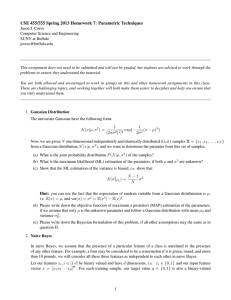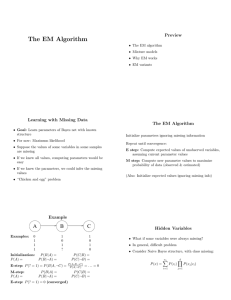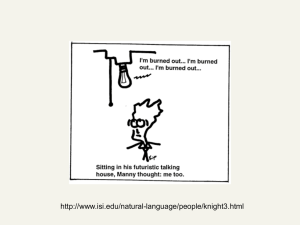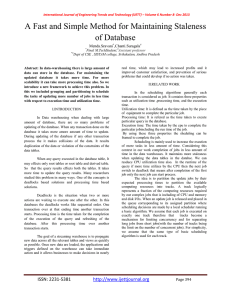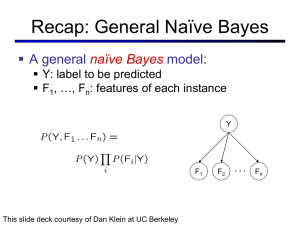Resit
advertisement
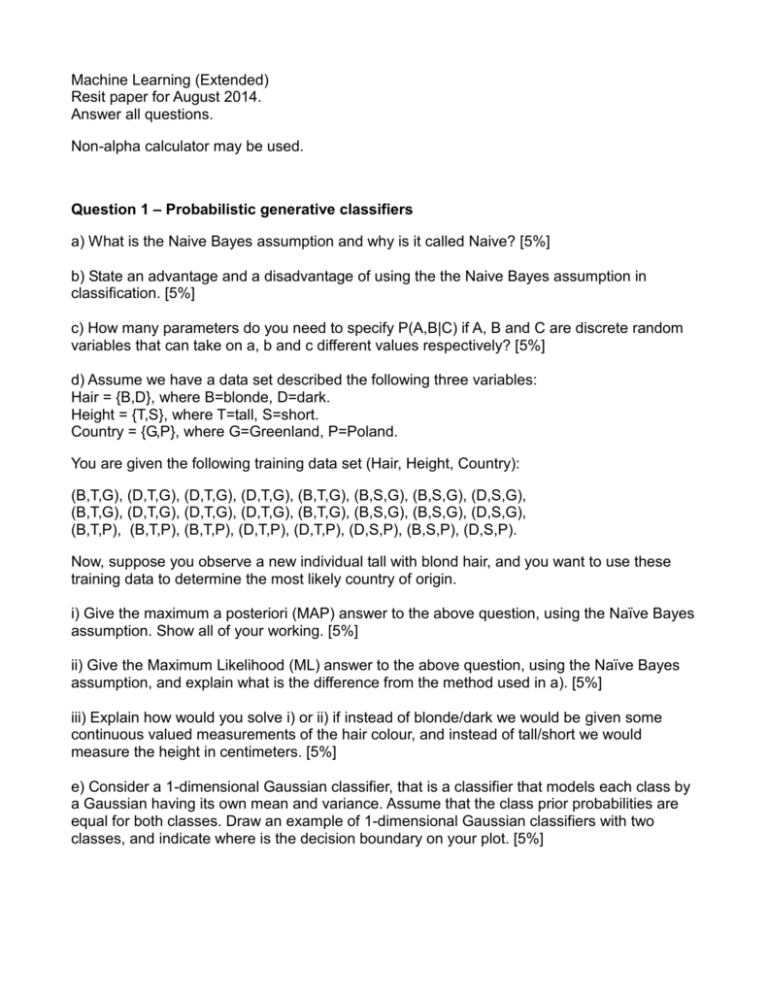
Machine Learning (Extended)
Resit paper for August 2014.
Answer all questions.
Non-alpha calculator may be used.
Question 1 – Probabilistic generative classifiers
a) What is the Naive Bayes assumption and why is it called Naive? [5%]
b) State an advantage and a disadvantage of using the the Naive Bayes assumption in
classification. [5%]
c) How many parameters do you need to specify P(A,B|C) if A, B and C are discrete random
variables that can take on a, b and c different values respectively? [5%]
d) Assume we have a data set described the following three variables:
Hair = {B,D}, where B=blonde, D=dark.
Height = {T,S}, where T=tall, S=short.
Country = {G,P}, where G=Greenland, P=Poland.
You are given the following training data set (Hair, Height, Country):
(B,T,G), (D,T,G), (D,T,G), (D,T,G), (B,T,G), (B,S,G), (B,S,G), (D,S,G),
(B,T,G), (D,T,G), (D,T,G), (D,T,G), (B,T,G), (B,S,G), (B,S,G), (D,S,G),
(B,T,P), (B,T,P), (B,T,P), (D,T,P), (D,T,P), (D,S,P), (B,S,P), (D,S,P).
Now, suppose you observe a new individual tall with blond hair, and you want to use these
training data to determine the most likely country of origin.
i) Give the maximum a posteriori (MAP) answer to the above question, using the Naïve Bayes
assumption. Show all of your working. [5%]
ii) Give the Maximum Likelihood (ML) answer to the above question, using the Naïve Bayes
assumption, and explain what is the difference from the method used in a). [5%]
iii) Explain how would you solve i) or ii) if instead of blonde/dark we would be given some
continuous valued measurements of the hair colour, and instead of tall/short we would
measure the height in centimeters. [5%]
e) Consider a 1-dimensional Gaussian classifier, that is a classifier that models each class by
a Gaussian having its own mean and variance. Assume that the class prior probabilities are
equal for both classes. Draw an example of 1-dimensional Gaussian classifiers with two
classes, and indicate where is the decision boundary on your plot. [5%]
Question 2 – Non-probabilistic classifiers
a) Consider the following training data from 2 categories:
Class1: (1,1)’
Class 2: (-1,-1)’, (1,0)’, (0,1)’
i) Plot these four points, draw the linear separation boundary that SVM would give for these
data, and list the support vectors. [5%]
ii) Consider training data of 1-dimensional points from two classes:
Class 1: -5,5
Class 2: -2,1
A) Consider the transformation f: RR2, f(x)=(x,x2). Transform the data and plot these
transformed points. Are these linearly separable? [5%]
B) Draw the optimal separating hyper-plane in the transformed space, and explain in one or
two sentences how does this linear boundary help us to separate the original data points.
[5%]
b) Consider the following data set with two real-valued inputs x (i.e. the coordinates of the
points) and one binary output y (taking values + or -). We want to use k-nearest neighbours
(K-NN) with Euclidean distance to predict y from x.
i) Calculate the leave-one-out cross-validation error of 1-NN on this data set. That is, for each
point in turn, try to predict its label y using the rest of the points, and count up the number of
misclassification errors. [5%]
ii) Calculate the leave-one-out cross-validation error of 3-NN on the same data set. [5%]
iii) Describe how would you choose the number of neighbours K in K-NN in general? [5%]
c) Suppose you have a data set to classify and you have several classification methods that
you can try. Explain how do you decide which of these methods to choose [5%]
Question 3 – Learning theory
a) State three questions that are studied by learning theory. [5%]
b) A learning theory framework is the PAC model of learning, where PAC stands for Probably
Approximately Correct. Explain in plain English when do we say that a concept class is PAClearnable. [5%]
Question 4 – Unsupervised learning: Clustering
a) What methods to you know for data clustering? [5%]
b) Describe how you would use a clustering method to do image segmentation. [5%]
c) Describe two limitations of the K-means clustering algorithm. [5%]
d) Suppose you have run K-means clustering on a data set and later you get more data point
into the same data set. How would you cluster the new points without re-running the algorithm
? [5%]
Link to learning the outcomes assessed by examination
1. Demonstrate a knowledge and understanding of the main approaches to machine learning.
Q1 a,c,e; Q2 a, b; Q3; Q4 a.
2. Demonstrate the ability to apply the main approaches to unseen examples.
Q1 d; Q2 b; Q3; Q4 d.
3. Demonstrate an understanding of the differences, advantages and problems of the main
approaches in machine learning.
Q1 d iii; Q2 c.
4. Demonstrate an understanding of the main limitations of current approaches to machine
learning, and be able to discuss possible extensions to overcome these limitations.
Q1 b; Q2 c; Q4 c.


